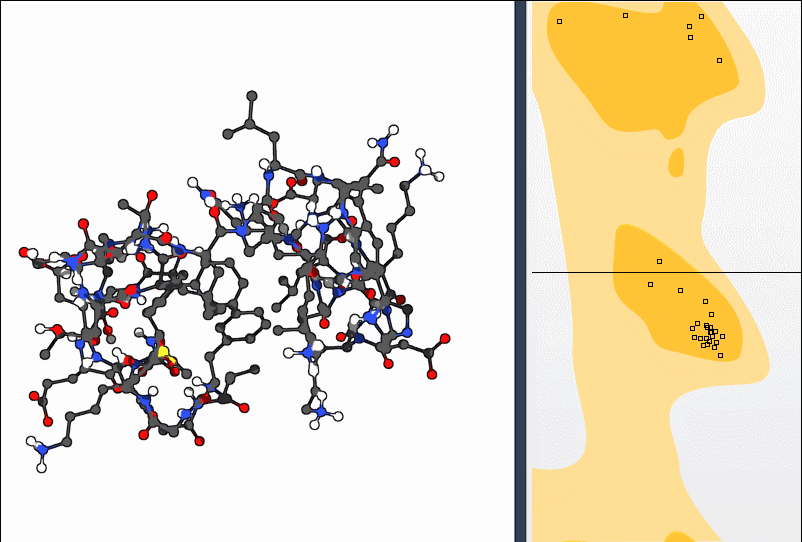When working with protein models, it’s not uncommon to encounter residues adopting unfavorable conformations. These outliers can emerge during homology modeling, loop building, or even after seemingly successful refinements. Spotting and correcting them efficiently is crucial for improving model quality before simulation or further analysis.
Fortunately, the Interactive Ramachandran Plot extension in SAMSON offers an intuitive interface to explore and directly edit backbone dihedral angles (φ and ψ) using a live 3D view and plot synchronization. This provides molecular modelers with precise control over local geometry—without guesswork or repetitive iterations.
Edit by Dragging a Point
Let’s say you’ve loaded a protein structure (for example, PDB ID 1YRF) and a few residues fall outside the energetically favored regions in the Ramachandran plot. From the app:
- Select the residue by clicking on the outlier in the plot.
- Simply drag the dot within the diagram into a favorable zone.
- The 3D structure updates immediately to reflect the edited conformation.

This immediate visual feedback loop makes it easier to tweak phi and psi angles purposefully, while checking that the structural consequences are acceptable.
Use the Twister Editor for Direct Manipulation
Some users may prefer interacting with the molecule directly in 3D space. For that, SAMSON offers the Twister Editor—a viewport tool that allows manual adjustment of local torsions. Here’s how:
- Activate the Twister Editor from the left-hand menu.
- Click the bond control handles to adjust torsion angles interactively.
- As you twist residues, observe real-time updates in the Ramachandran plot.

This approach is particularly helpful when residues are constrained spatially with contacts or forming loops, giving you a fine-grained handle on conformational tuning.
Undoing Changes
If you’re not satisfied with a change, you can undo it using:
Ctrl / Cmd + Z
This makes exploration safe and reversible, encouraging experimentation without risk of data loss.
Why It Matters
Residue-level manual control enables downstream improvements in simulation reliability and model interpretability. Applications include:
- Fixing strained loops and outliers in homology models
- Improving side-chain packing
- Tuning active site conformations for docking studies
And by combining this editing workflow with normal mode analysis, you even have the option to explore global-local coupling effects (as shown in the bonus challenge).
Want to learn more or get started? Read the full documentation for the Interactive Ramachandran Plot at this link.
SAMSON and all SAMSON Extensions are free for non-commercial use. You can download SAMSON at https://www.samson-connect.net.





